| 9th Frigate Squadron | |
|---|---|
| Active | 1965 – March 1993 |
| Country | |
| Branch | |
| Size | Squadron |
| Commanders | |
| First | Captain William C. McKnight |
| Last | Captain James F. Perowne |
The 9th Frigate Squadron was an administrative unit of the Royal Navy from 1985 to 1993.
| 9th Frigate Squadron | |
|---|---|
| Active | 1965 – March 1993 |
| Country | |
| Branch | |
| Size | Squadron |
| Commanders | |
| First | Captain William C. McKnight |
| Last | Captain James F. Perowne |
The 9th Frigate Squadron was an administrative unit of the Royal Navy from 1985 to 1993.
| Commander | Ship | Dates |
|---|---|---|
| Captain William C. McKnight | HMS Brave | 1985-March 1987 |
| Captain Fabian M. Malbon | HMS Brave | March 1987-August 1988 |
| Captain Andrew B. Gough | HMS Brave | August 1987-December 1989 |
| Captain Jonathon Band | HMS Norfolk | 1989-1991 |
| Captain R.John Lippiett | HMS Norfolk | 1991-1992 |
| Captain James F. Perowne | HMS Norfolk | 1992-March 1993 |

The Fleet Air Arm (FAA) is the naval aviation component of the United Kingdom's Royal Navy (RN). The FAA is one of five RN fighting arms. As of 2023 it is a predominantly "rotary" force, with helicopters undertaking roles once performed by biplanes such as the Fairey Swordfish. It operates the F-35 Lightning II for maritime strike and the AW159 Wildcat and AW101 Merlin for commando and anti-submarine warfare.
Rear admiral is a senior naval flag officer rank, equivalent to a major general or divisional general and air vice marshal and above that of a commodore and captain, but below that of a vice admiral.

The Home Fleet was a fleet of the Royal Navy that operated from the United Kingdom's territorial waters from 1902 with intervals until 1967. In 1967, it was merged with the Mediterranean Fleet creating the new Western Fleet.
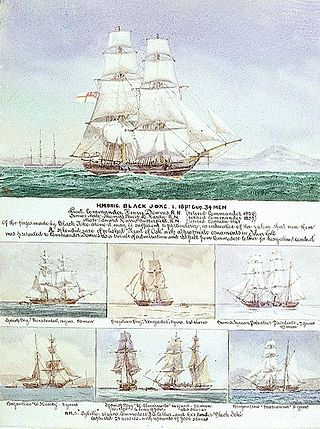
The West Africa Squadron, also known as the Preventative Squadron, was a squadron of the British Royal Navy whose goal was to suppress the Atlantic slave trade by patrolling the coast of West Africa. Formed in 1808 after the British Parliament passed the Slave Trade Act 1807 and based out of Portsmouth, England, it remained an independent command until 1856 and then again from 1866 to 1867.

The Gibraltar Squadron is a unit of the British Royal Navy. It is the only seagoing Royal Naval unit based in Gibraltar, attached to British Forces Gibraltar. It currently includes two Cutlass-class fast patrol boats with a maximum speed of up to 41-knots. The squadron also uses three Pacific 24 rigid-hulled inflatable boats and deploys one diving support boat. The 2021 defence white paper indicated that henceforth, one River-class offshore patrol vessel, HMS Trent, would also be permanently based in Gibraltar for operations in the Mediterranean and in the Gulf of Guinea. As of 2023, 28 personnel were assigned to the squadron, along with additional personnel assigned to HMS Trent.
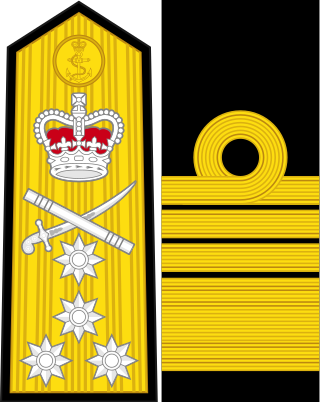
Admiral is a senior rank of the Royal Navy, which equates to the NATO rank code OF-9, outranked only by the rank of admiral of the fleet. Royal Navy officers holding the ranks of rear admiral, vice admiral and admiral of the fleet are sometimes considered generically to be admirals. The rank of admiral is currently the highest rank to which a serving officer in the Royal Navy can be promoted, admiral of the fleet being in abeyance except for honorary promotions of retired officers and members of the Royal Family.

The Channel Fleet and originally known as the Channel Squadron was the Royal Navy formation of warships that defended the waters of the English Channel from 1854 to 1909 and 1914 to 1915.
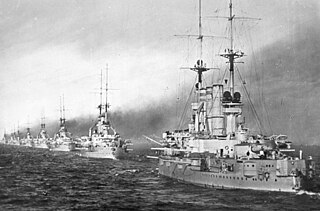
A squadron, or naval squadron, is a significant group of warships which is nonetheless considered too small to be designated a fleet. A squadron is typically a part of a fleet. Between different navies there are no clear defining parameters to distinguish a squadron from a fleet, and the size and strength of a naval squadron varies greatly according to the country and time period. Groups of small warships, or small groups of major warships, might instead be designated flotillas by some navies according to their terminology. Since the size of a naval squadron varies greatly, the rank associated with command of a squadron also varies greatly.
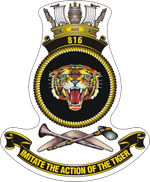
816 Squadron is a Royal Australian Navy Fleet Air Arm squadron that started out as a Royal Navy unit, 816 Naval Air Squadron.

805 Squadron was a Royal Australian Navy Fleet Air Arm squadron. Originally formed as 805 Naval Air Squadron of the Royal Navy Fleet Air Arm in 1940 and operating for the duration of World War II in both the Mediterranean and Pacific theatres. 805 Squadron was recreated as a unit of the Royal Australian Navy (RAN) in 1948, and operated from Australian aircraft carriers until 1982, having the distinction of being the last fast jet squadron in the RAN. 805 Squadron was re-established in 2001 to operate the Kaman Super Seasprite as a replacement for helicopters currently in service, but problems with the helicopters saw the project cancelled and the squadron disbanded in 2008.

723 Squadron is a Royal Australian Navy Fleet Air Arm squadron. The squadron was first raised in 1952 and throughout its history has served operationally during the Vietnam War, the Gulf War and in East Timor. It currently operates as a helicopter training squadron and is based at HMAS Albatross at Nowra, New South Wales.

815 Naval Air Squadron is a Royal Navy Fleet Air Arm squadron flying the AgustaWestland Wildcat HMA.2 helicopter and is the Navy's front line Wildcat Naval Air Squadron. The squadron is based at RNAS Yeovilton in Somerset. The squadron is capable of carrying out multiple roles such as: counter-narcotics, anti-piracy, Above Surface Warfare (ASW), search and rescue, disaster relief and flying and engineering training. In the early 2000s, the Navy said that the squadron was largest helicopter squadron in Europe.
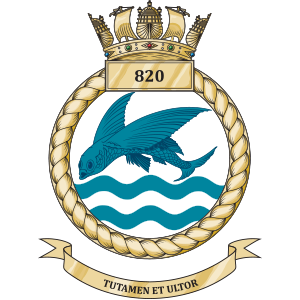
820 Naval Air Squadron is a Royal Navy Fleet Air Arm carrier-based squadron flying the AgustaWestland Merlin HM2 in Anti-Submarine and Airborne Early Warning (AEW) roles from RNAS Culdrose.

808 Naval Air Squadron is a ship-based helicopter squadron of the Royal Australian Navy.
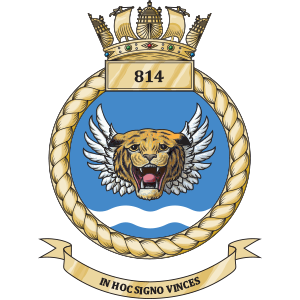
814 Naval Air Squadron or 814 NAS, nicknamed the Flying Tigers, is a squadron of the Royal Navy Fleet Air Arm. It is currently equipped with the AgustaWestland Merlin HM2 anti-submarine warfare helicopter and is based at Royal Naval Air Station (RNAS) Culdrose in Cornwall. The squadron was formed in December 1938 and has been disbanded and reformed several times.
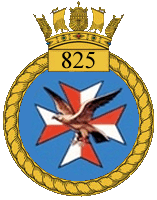
825 Naval Air Squadron is a Royal Navy Fleet Air Arm Naval Air Squadron which was re-commissioned on 10 October 2014 and currently flies the AgustaWestland Wildcat HMA2.

725 Squadron is a naval aviation squadron of the Royal Australian Navy (RAN) Fleet Air Arm. The squadron was originally created in August 1943 as part of the Fleet Air Arm of the Royal Navy. It initially served as a fleet requirements unit, was rerolled in August 1945 as a target towing unit, then was disbanded in December 1945. In January 1958, the squadron was re-formed, as a fleet requirements and communications unit of the RAN, operating a variety of fixed-wing aircraft. The squadron was redesignated as an anti-submarine warfare training squadron in May 1959, then was decommissioned in May 1961 and absorbed into 724 Squadron. 725 Squadron was recommissioned in November 1962 as an operational anti-submarine helicopter squadron, flying the Westland Wessex. During this commission, the squadron was involved in HMAS Sydney's troop transport voyages, the rescue of personnel following the Melbourne-Voyager collision, and the Operation Navy Help Darwin relief effort post-Cyclone Tracy. The squadron was decommissioned in December 1975. 725 Squadron was commissioned for the fourth time in June 2015, this time as a training unit for MH-60R Seahawk Romeo helicopters: the squadron had been reactivated two years prior as a non-commissioned unit train on and accept into service the Romeos.
Rear admiral (RAdm) is a flag officer rank of the Royal Navy. It is immediately superior to commodore and is subordinate to vice admiral. It is a two-star rank and has a NATO ranking code of OF-7.

A squadron in an air force, or naval or army aviation service, is a unit comprising a number of military aircraft and their aircrews, usually of the same type, typically with 12 to 24 aircraft, sometimes divided into three or four flights, depending on aircraft type and air force.